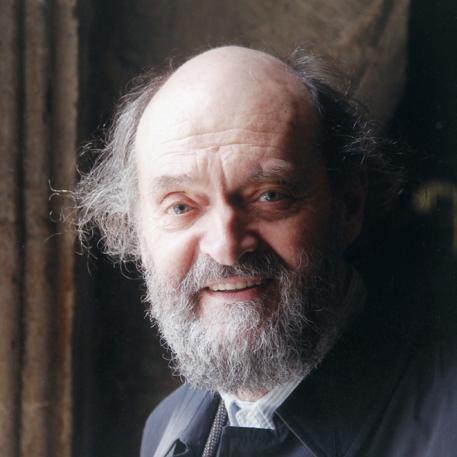
Pesti Vigadó – Díszterem
Pesti Vigadó – Concert Hall
Arvo Pärt: Tabula rasa – két hegedűre, preparált zongorára és vonószenekarra • for two violins, prepared piano and string orchestra
Arvo Pärt: Fratres – Vambola Krigul átirata ütőhangszeres kvartettre
• arranged for percussion quartet by Vambola Krigul
Arvo Pärt: Cantus Benjamin Britten emlékére – vonószenekarra és harangra • Cantus in Memory of Benjamin Britten – for string orchestra and a bell
szünet • interval
Riho Esko Maimets: Soliloquy – ütőhangszerekre, zongorára és vonószenekarra • for percussion, piano and strings – magyarországi bemutató • Hungarian premiere
Arvo Pärt: Salve Regina – énekkarra, cselesztára és vonószenekarra
• for choir, celesta and string orchestra
Liszt: Salve Regina
Arvo Pärt: Spiegel im Spiegel – csellóra és zongorára
• for violoncello and piano
Arvo Pärt: Silhouette (Hommage à Gustave Eiffel) – ütőhangszerekre és vonószenekarra • for string orchestra and percussion
Közreműködik • Featuring: Peeter MARGUS, Lisanne ALTROV-MARGUS –hegedű • violin, Andreas LEND – cselló • cello, Maila LAIDNA – zongora
• piano, Estonian Percussion Group (az együttes tagjai • the members of the group: Karl Johann LATTIKAS, Tanel-Eiko NOVIKOV, Tiit JOAMETS, MARJÁN Csaba Zoltán), Eesti Sinfonietta, Új Liszt Ferenc Kamarakórus
• New Liszt Ferenc Chamber Choir (karigazgató • choirmaster: MÉSZÁROS Péter)
Vezényel • Conductor: Erki PEHK
Az előadás a Liszt Ünnep keretében a Pesti Vigadóval közös programként, a Müpa szervezésében valósul meg. Partner: Magyar Művészeti Akadémia • This concert of the Liszt Fest is presented by Müpa Budapest as a joint event with Pesti Vigadó. Partner: Hungarian Academy of Arts
For the English version see page 8.
Arvo Pärt: Tabula rasa –két hegedűre, preparált zongorára és vonószenekarra „Bizonyos mértékben a Tabula rasa Gidon Kremer sugalmazására született, magam mindig féltem az új ötletektől. Egyszer megkérdeztem Gidont, szerinte képes lennék-e lassú zenét komponálni. Gidon azt felelte, hogy persze. Ezek után a darabot igen gyorsan befejeztem. A hangszerelés – két szólóhegedű, preparált zongora, vonósok – Schnittke egy akkoriban bemutatott, ugyanilyen összeállítású darabjához hasonlít.” Így emlékezett vissza Arvo Pärt (1935) az 1977-ben komponált darab keletkezési körülményeire. Az első tétel a barokk concertók világát idézi, a második centrumában egy tiszta moll-akkord áll. A hangzó anyag mozgása fokozatosan kialszik, majd feloldódik a csendben.
Arvo Pärt: Fratres – Vambola Krigul átirata ütőhangszeres kvartettre A hetvenes években – részben a gregorián, illetve 14–16. századi francia és franko-flamand zeneszerzők műveinek hatására – gyökeres változás állt be Pärt stílusában. „Felfedeztem, hogy elég, ha csupán egyetlen hangot szólaltatnak meg gyönyörűen. Ez az egyetlen hang, vagy egy csendes ütés, vagy egy pillanatnyi csend megvigasztal. Nagyon kevés elemmel dolgozom: egy hanggal, két hanggal… Egyszerű anyagokból építkezem –egy hármashangzatból, egy bizonyos tonalitásban. A hármashangzat hangjai harangokhoz hasonlítanak, ezért hívom ezt a kompozíciós eljárást tintinnabulinak.” (A latin eredetű „tintinnabuli” szó harangocskákra utal.)
A Fratres a tintinnabuli-stílus jellegzetes és máig igen népszerű darabja, melyet a koncerteken sokféle hangszer-összeállításban szólaltathatnak meg, a hangszerelési változatok egy részét nem Pärt készítette. A kompozíció filmek kísérőzenéjeként is gyakran elhangzik. Az észt ütőhangszeres művész, Vambola Krigul (1981) a PaukenfEST ütőhangszeres kvartett alapítója. Az együttes repertoárjának fontos részét képezi az észt kortárs zene, olyan szerzőktől rendel darabokat, mint Eino Tamberg, Lepo Sumera, Sven Grünberg, Ülo Krigul vagy Margo Kõlar.
Arvo Pärt: Cantus Benjamin Britten emlékére –vonószenekarra és harangra
A Cantus in Memory of Benjamin Britten nem sokkal az angol zeneszerző halála (1976) után keletkezett, és a zeneszerző jellegzetes tintinnabulistílusú kompozícióinak egyik legnépszerűbb képviselője. A vonószenekarra és harangra írt darab tonális centruma a harang „A” hangja. Az a-moll skála fokaira épülő tétel lényegében igen egyszerű (a szólamok közötti kapcsolat a prolációs kánontechnikára vezethető vissza: ugyanaz a dallam
különböző sebességgel hangzik el az egyes szólamokban), mégis drámai és hatásos. Az egész mű a hangzó zene és a csend kapcsolatán keresztül egyfajta „halál feletti meditáció”. Az elején és végén „hallható” hosszú csendet Pärt beírta a partitúrába, a zenemű hallgatója így maga is részt vesz a darab előadásában. A Pärt zenéjét mélyen ismerő Paul Hillier így fogalmazott: „Az, hogy miként élünk, elsősorban a halálhoz fűződő viszonyunktól, az pedig, hogy miként zenélünk, a csenddel való kapcsolatunktól függ. A darab csenddel kezdődik, és csenddel végződik, ez teremti meg a keretet; utalva arra, hogy a csendből jövünk, és visszatérünk a csendbe.”
Riho Esko Maimets: Soliloquy –ütőhangszerekre, zongorára és vonószenekarra – magyarországi bemutató Riho Esko Maimets (1988) zeneszerzői diplomáját a philadelphiai Curtis Zenei Intézetben, David Ludwig és Richard Danielpour tanítványaként szerezte. Pályája során elnyerte többek között a Karen Kieser-díjat (Kanada), a highSCORE-díjat (Olaszország) és a Theodore Presser Zenei Díjat (USA), 2012-ben ő lett a Villiers Quartet Verseny (Egyesült Királyság) győztese. 2019-ben az Észt Kórusszövetség neki ítélte „Az év kóruszeneszerzője” díjat, 2021-ben pedig megkapta a Riho Pats Iskola Zenei Alapítvány ösztöndíját. „A Soliloquy-t a minket körülvevő világ kérdéseire adott bensőséges, őszinte és kendőzetlen válaszként írtam. Mint sok más művem a közelmúltból, ez a kompozíció is a fájdalom és a bánat feldolgozására tesz kísérletet.”
Arvo Pärt: Salve Regina – énekkarra, cselesztára és vonószenekarra
Pärt himnuszmegzenésítése 2001-ben keletkezett, eredetileg vegyeskarra és orgonára; első ízben az esseni katedrálisban adták elő 2002-ben. 2011-ben, az egységes Olaszország megteremtésének 150. évfordulójára a zeneszerző énekkarra, vonószenekarra és cselesztára dolgozta át. A lassan, kimérten építkező kompozíció fokozatosan ér fel – ahogy egy elemzője fogalmazott – a „távoli, fenséges csúcspontra”.
A Salve Regina zenei szerkezete egy tölcsérhez hasonlítható. A darab nagy, lassan forgó „körökkel” kezdődik, majd egyre koncentráltabbá és komolyabbá válik, amíg el nem éri a legmélyebb pontot. Az egyik oldalon ott a hangzás hatalmas tömege, a másikon pedig egy nagyon egyszerű, liturgikus környezetben ritkán előforduló, 3/4-ben pulzáló anyag, mely a kódában éri el legnagyobb sűrűségét.
Liszt Ferenc: Salve Regina
A Salve Regina, Liszt kései kompozíciója 1885-ben született. A darab a zeneszerző egyetlen hangszerkíséret nélküli, vegyeskarra komponált egyházzenei alkotása, egyben utolsó liturgikus műve. Előképe egy 1877-ben írt orgonadarab, a Zwei Kirchenhymnen (Két templomi himnusz). A megkapóan szép kóruskompozíció 2024-ben Menus Gabriella karnagy irányításával, a Szent Angéla Kórus előadásában elhangzott a római Szent Péter téren, egy Ferenc pápa által vezetett általános audiencián.
Arvo Pärt: Spiegel im Spiegel – csellóra és zongorára
Pärt ezt a művét 1978-ban, Észtországból való emigrálásának évében komponálta, eredetileg hegedűre és zongorára. A darab utóbb Pärt stílusfordulatának (tintinnabuli) emblematikus művévé vált. Egyszerű, hármashangzatra épülő harmóniák felett bontakozik ki a hosszú hangjegyértékekben mozgó dallam. A látszólag egyszerű kompozíció életre keltése nagy kihívást jelent az előadók számára. A zeneszerző úgy véli, játék közben „minden felesleges dolgot félre kell tenni. Ahogy a zeneszerzőnek csökkentenie kell az egóját a zene írásakor, úgy a zenésznek is félre kell tennie a magáét.” A Spiegel im Spiegel azon művek egyike, amelyekből a zeneszerző és mások is számos változatot készítettek a legkülönbözőbb hangszerkombinációkra. Zenéjét gyakran használták balett- és táncelőadásokhoz, filmekhez.
Arvo Pärt: Silhouette (Hommage à Gustave Eiffel) –ütőhangszerekre és vonószenekarra
Arvo Pärt így írt a darabról: „Egy, az Eiffel-toronyhoz készült, vázlatokkal és tervrajzokkal illusztrált csodálatos könyv egészen magával ragadott, egy ideje már ott feküdt az asztalomon. Lenyűgözött Eiffel művészi víziója, melyben a tiszta racionalitás és az elegancia ötvöződik. Komponistaként szemlélve az Eiffel-torony számos olyan tulajdonsággal rendelkezik, mely összevethető egy zenemű szerkezetével: a szerkezeti elemek közötti kapcsolatok, a konstrukció transzparenciája és még sok egyéb. Még az építőművészet egyik fontos elve, a stabilitás, mozdulatlanság (stasis) is alapvető szerepet játszhat egy zeneműben. Silhouette című kompozícióm rövid és könnyed, van benne valami szédítő, mint egy táncban, egy keringőben – talán olyan, mint a szél, amely simogatja ezt a csúcsos kolosszust.”
Peeter MARGUS
Peeter Margus 2019-ben szerezte alapdiplomáját a finn Sibelius Akadémián, a mesterképzést az Észt Zene- és Színházművészeti Akadémián végezte Mari Tampere-Bezrodny osztályában. 2016-tól 2022-ig a Tallinni Kamarazenekar tagja volt, 2023-tól az Észt Sinfonietta koncertmestere. 2022 óta az Észt Zeneakadémia tudományos munkatársa, emellett doktori tanulmányait végzi.
Lisanne ALTROV-MARGUS
Hegedűművészi alapdiplomáját Arvo Leibur növendékeként az Észt Zeneés Színházművészeti Akadémián szerezte 2016-ban. Még ugyanebben az évben felvételt nyert a bécsi Zenei és Művészeti Magánegyetemre, ahol barokk előadó-művészeti mestertanulmányokat is folytatott. Hegedűművészi képzése mellett zenepszichológiát tanul a bécsi Zene- és Előadóművészeti Egyetemen. Tagja volt a Tallinni Kamarazenekarnak, szólistaként több ízben is fellépett az Észt Nemzeti Szimfonikusokkal. Bécsben rendszeresen koncertezik a harmonikás Elisabeth Müller (Duo Vineta), az Orchester Wiener Akademie, a Wiener Ensemble és a Strauss Capelle Wien társaságában. 2025 óta a Balthasar Neumann Orchestra tagja.
Andreas LEND
Andreas Lend az Észt Zene- és Színházművészeti Akadémián, majd a finn
Sibelius Akadémián végezte csellótanulmányait. Több külföldi és hazai versenyen szerepelt sikerrel, 2006 és 2016 között az Észt Nemzeti Szimfonikus Zenekar tagja volt, jelenleg az Észt Nemzeti Opera első csellistája, de játszik a Prezioso Vonósnégyesben és az Észt Csellóegyüttesben is.
Maila LAIDNA
Maila Laidna az Észt Zene- és Színházművészeti Akadémián szerezte meg zongoraművészi és kamaramuzsikusi diplomáját, majd Spanyolországban, a Vigói Konzervatóriumban képezte tovább magát. Jelenleg doktori tanulmányokat folytat Észtországban. 2013 óta Tiiu Sisask partnereként zongoraduóban játszik. Kettősük több díjat is kapott, 2015-ben harmadik helyezettek lettek a Római Nemzetközi Zongoraversenyen, 2019-ben megnyerték a szentpétervári Maria Jugyina Versenyt és második helyezést értek el a Philadelphiai Kamarazenei Versenyen, 2021-ben pedig aranyéremmel jutalmazták őket a Zongoratanárok Világszervezetének III. Nemzetközi Zongoraversenyén, Finnországban. 2016-tól az Ensemble Auftakt hegedű-klarinét-zongora trió tagja, az együttessel első helyezett lett a budapesti Danubia Talents Nemzetközi Zenei Versenyen.

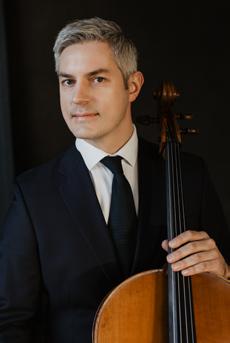
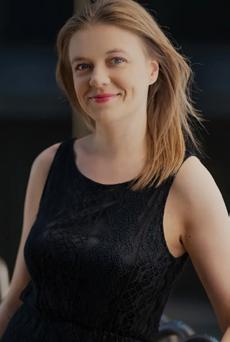
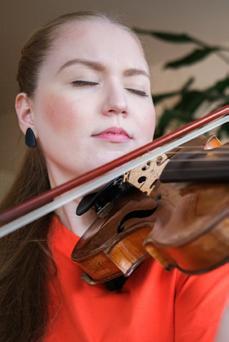
Erki PEHK
Erki Pehk a tallinni Zeneakadémián végezte zongora- és karvezetéstanulmányait, majd Rigában és Londonban képezte tovább magát karmester szakon. 1994-től 2011-ig az Észt Nemzeti Opera karmestereként több mint hétszáz előadást vezényelt. 2010-ben Észt Állami Díjjal tüntették ki. Vendégkarmesterként Magyarországon és a balti államokon kívül fellépett Németországban, Franciaországban, Bulgáriában, Belgiumban, Hollandiában, Oroszországban és Ukrajnában. Neves szólisták, többek között Tatjana Grindenko, Max Emanuel Cenčić, Camilla Hoitenga, Barbara Hendricks és Markus Stockhausen partnere volt. 2000-ben alapította meg a 21. Század Zenekarát, mely elsősorban a kortárs zene megszólaltatását tekinti fő feladatának. 2001 óta a PromFest, a Pärnui Nemzetközi Operafesztivál művészeti igazgatója, és jelenleg a litván Panevėžys Zenés Színház vezető karmestere.
Estonian Percussion Group
Az együttes négy kiváló észt ütőhangszeres művészből áll, akik a legkülönbözőbb műfajokban mozognak otthonosan. Az ütőhangszeres klaszszikusoktól a barokkon át a rockig terjedő repertoárjukat az együttes felkérésére komponált észt darabokkal gazdagítják.
Eesti Sinfonietta
Az Eesti Sinfonietta szenvedélyes és szólistaképességekkel rendelkező zenészekből áll, akik az előadásokat nem nehézségekkel járó feladatnak tekintik, egyszerűen csak élvezik, hogy olyan zenét játszhatnak, amit szeretnek. Az együttes összetétele rugalmasan változik, kisebb apparátusra írt műveket éppúgy játszanak, mint szimfonikus alkotásokat. Gyakran lépnek fel karmester nélkül, ami kiemeli a művek kamarazenei jellegét, és személyesebb, kifejezőbb interpretációt eredményez. A repertoár kialakításakor fontos szempont, hogy az együttes tagjai szólistaként is megmutatkozhassanak.
Új Liszt Ferenc Kamarakórus
A kórus a Liszt Ferenc Zeneművészeti Egyetem Alma Mater Kórusából, illetve a közelmúltban végzett fiatal muzsikusok közül választja tagjait. Fő célja annak a hagyománynak az újraélesztése, melyet az egyetemen Párkai István teremtett meg (1963–1993). Ennek lényege, hogy az együttes a klasszikus kórusrepertoár mellett a kortárs kórusirodalom ritkábban hallható és nehezebben megközelíthető alkotásait is műsorára tűzze, magyar és külföldi kortárs szerzők műveinek bemutatásával folyamatosan jelen legyen a magyar zenei életben, egyben példázza az egyetemen folyó magas színvonalú muzsikusképzést. A kórus élén Mészáros Péter áll.
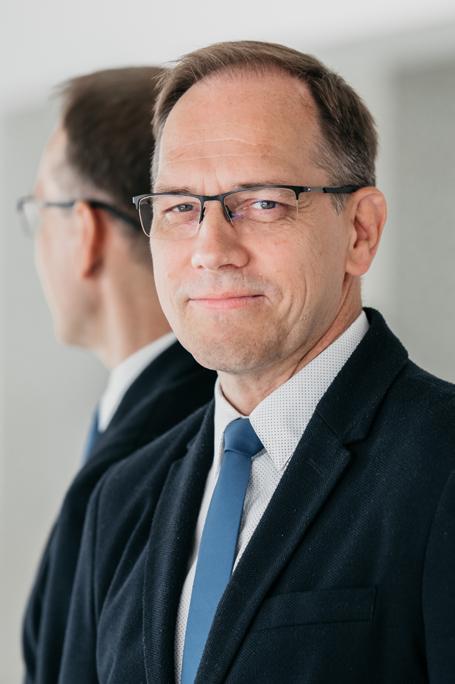
Arvo Pärt: Tabula rasa – for two violins, prepared piano and string orchestra ‘To a certain extent, Tabula rasa was inspired by Gidon Kremer. I myself was always wary of new ideas. Once I asked Gidon whether he thought I would be able to compose slow music. He said, of course. After which I finished the piece very quickly. The instrumentation – two solo violins, a prepared piano and strings –resembles a piece by Schnittke, which has the same instruments and was presented at around that time,’ recalled Pärt (b. 1935) the circumstances under which the piece was composed in 1977. The first movement is reminiscent of the world of baroque concertos, while the second centres around a pure minor chord. The material gradually slows down and eventually dissolves in silence.
Arvo Pärt: Fratres – Vambola Krigul’s arrangement for percussion quartet In the 1970s, due in part to the influence of Gregorian chants and the works of 14th to 16th-century French and Franco-Flemish composers, Arvo Pärt’s style underwent a fundamental change. ‘I discovered it was enough to sound a single note beautifully. This single note, or a quiet beat, or a moment of silence, is comforting. I work with very few elements: one note, two notes… I build from simple materials – from a triad, in a certain tonality. The three tones of the triad resemble bells, which is why I call this compositional method tintinnabuli’ (from the Latin word for ‘small bells’). Fratres is a characteristic and still very popular piece of the tintinnabuli style, and can be played at concerts by a variety of formations. Some of the arrangements were not made by Pärt. The composition is also often used as incidental music for films. Estonian percussionist Vambola Krigul (b. 1981) is the founder of the percussion quartet PaukenfEST. Estonian contemporary music is an important part of the ensemble’s repertoire, and it has commissioned works from such composers as Eino Tamberg, Lepo Sumera, Sven Grünberg, Ülo Krigul and Margo Kõlar.
Arvo Pärt: Cantus in Memory of Benjamin Britten –for string orchestra and bell
Cantus in Memory of Benjamin Britten was written shortly after the English composer’s death in 1976. Composed for string orchestra and bell (the bell’s ‘A’ is the tonal centre of the work), it is one of the most popular of the works in the composer’s distinctive style (tintinnabuli): based on the steps of the A minor scale, the movement is essentially very simple (the relationship between the parts is based on the technique of the prolation canon), yet dramatic and effective. The relationship between musical sounds and silence makes the whole work a ‘meditation on death.’ The long silence at the beginning and end of the piece is part of the score, making the listener participate in its performance. Said
Paul Hillier, who knows Pärt’s music intimately: ‘how we live depends on our relationship with death, how we make music depends on our relationship to silence. This silence creates a frame around the piece and has spiritual significance. It suggests that we come from silence and return to silence.’
Riho Esko Maimets: Soliloquy for percussion, piano and strings –Hungarian premiere
Riho Esko Maimets (1988) recently completed a Diploma in Composition at the Curtis Institute of Music in Philadelphia under the instruction of David Ludwig and Richard Danielpour. He has been the recipient of numerous awards, including the Karen Kieser Prize in Canadian Music, the highSCORE prize (Italy), the first prize at the 2012 Villiers Quartet Competition (UK), and the Theodore Presser Music Award (US). The Estonian Choral Association named him Choral Composer of the Year 2019. In 2021, Riho Esko Maimets won the Riho Päts School Music Foundation Stipendium. ‘I wrote Soliloquy as an intimate, honest and unvarnished response to the world around me. Like many of my recent works, I attempt to grapple with pain and sorrow.’
Arvo Pärt: Salve Regina – for choir, celesta and string orchestra
Pärt wrote this musical setting for the hymn in 2001, originally for mixed choir and organ. It was first performed in Essen Cathedral in 2002. In 2011, the composer revised the work for the 150th anniversary of the unification of Italy, arranging it for choir, string orchestra and celesta. The composition builds slowly and deliberately, gradually reaching what a critic called ‘a distant, majestic climax.’
The music of Salve Regina is like a funnel, starting with large, slowly spinning ‘circles,’ becoming more and more concentrated and serious, until it reaches its deepest point. On one side, there is the huge mass of sound, and on the other, a very simple material that pulses, unusually for the liturgical context, in three-four time, reaching its greatest density in the coda.
Ferenc Liszt: Salve Regina
Salve Regina is a late composition by Liszt, written in 1885. It is his only piece of church music for mixed choir without instrumental accompaniment, as well as his last liturgical work. It is based on Zwei Kirchenhymnen (Two Church Hymns), an organ piece from 1877. In 2024, this beautiful choral composition was performed by the Szent Angéla Choir under the direction of Gabriella Menus, in Rome, on St Peter’s Square, during a general audience conducted by Pope Francis.
Arvo Pärt: Spiegel im Spiegel – for cello and piano
Pärt composed this work in 1978, the year he emigrated from Estonia. It has since proved to be an emblematic work of his new style, the tintinnabuli. Evolving through long notes, the melody unfolds against simple harmonies based on triads. Originally written for violin and piano, the seemingly simple composition is a challenge for performers. ‘Everything redundant must be left aside,’ said the composer. ‘Just like the composer has to reduce his ego when writing the music, the musician too must put his ego aside when performing the piece.’ Spiegel im Spiegel is one of those works of which the composer and others have made numerous versions for a wide variety of instrumental combinations. The piece has often been used as music for ballet and dance performances as well as films.
Arvo Pärt: Silhouette (Hommage à Gustave Eiffel) –for string orchestra and percussion
Arvo Pärt wrote about his piece: ‘A splendid book of illustrations of the plans and blueprints for the tower lay on my desk, captivating me. I was impressed and inspired in many different ways by Eiffel’s artistic vision, by his combination of sober rationality and elegance. From the perspective of a composer, Eiffel’s tower has many features which compare to the structure of a piece of music – the connections between the structural elements, the transparency of the construction, and much more. Even stasis, such an important aspect of architecture, is also a key element of a piece of music. As regards my work, Silhouette, the piece came out short and light, like a dance, a waltz, something dizzying – perhaps like the winds which caress this pointed colossus.’
Peeter MARGUS
Peeter Margus graduated from the Sibelius Academy of Finland in 2019, and then studied for his master’s degree at the Estonian Academy of Music and Theatre Arts in the class of Mari Tampere-Bezrodny. He was a member of the Tallinn Chamber Orchestra from 2016 to 2022, and has been the concertmaster of the Estonian Sinfonietta since 2023. Since 2022, he has been a research fellow at the Estonian Academy of Music and is pursuing his doctoral studies.
Lisanne ALTROV-MARGUS
She graduated as a violinist from the Estonian Academy of Music and Theatre Arts, where she was a student of Arvo Leibur, in 2016. In the same year, she was admitted to the Private University of Music and Performing Arts in Vienna, where she pursued master’s studies in Baroque performance practice. She is also studying music psychology at the University of Music and Performing Arts in Vienna. She was a member of the Tallinn Chamber Orchestra and has performed several times as a soloist with the Estonian National Symphony Orchestra. In Vienna, she regularly appears in concert with accordionist Elisabeth Müller (Duo Vineta), the Orchester Wiener Akademie, the Wiener Ensemble and the Strauss Capelle Wien. She has been a member of the Balthasar Neumann Orchestra since 2025.
Andreas LEND
Andreas Lend studied cello at the Estonian Academy of Music and Theatre Arts and later at the Sibelius Academy in Finland. He has successfully participated in several competitions in Estonia and abroad, was a member of the Estonian National Symphony Orchestra from 2006 to 2016, and is currently principal cellist of the Estonian National Opera, as well as a member of the Prezioso String Quartet and the Estonian Cello Ensemble.
Maila LAIDNA
Maila Laidna graduated as a pianist and chamber musician from the Estonian Academy of Music and Theatre Arts, and furthered her education at the Vigo Conservatory in Spain. She is currently pursuing her doctoral studies in Estonia. In 2013, she began a piano duo with Tiiu Sisask. The two have won several prizes, becoming third at the 25th International Piano Competition in Rome in 2015, first at the Maria Yudina Competition in St Petersburg and second at the Philadelphia Chamber Music Competition in 2019. In 2021 they were awarded the gold medal at the 3rd International Piano Competition of the World Piano Teachers’ Association Finland. Since 2016, she has also been a member of Ensemble Auftakt, a violin–clarinet–piano trio, which won the Danubia Talents International Music Competition in Budapest.
Erki PEHK
Erki Pehk studied piano and choral conducting at the Tallinn Academy of Music before continuing his orchestral conducting studies in Riga and London. As conductor of the Estonian National Opera between 1994 and 2011, he led more than 700 performances. In 2010, he was awarded the Estonian State Prize for Musical Theatre. He has performed as a conductor not only in Hungary and the Baltic States but also in Finland, Germany, France, Bulgaria, Belgium, the Netherlands, Russia and Ukraine. He has collaborated with renowned soloists such as Tatiana Grindenko, Max Emanuel Cenčić, Camilla Hoitenga, Barbara Hendricks and Markus Stockhausen. In 2000, he founded the 21st Century Orchestra, an ensemble dedicated to performing contemporary music. Since 2001, he has served as the Artistic Director of the Pärnu Opera Music Festival PromFest, and he is currently the Chief Conductor of the Panevėžys Music Theatre in Lithuania.
Estonian Percussion Group
Estonian Percussion Group is made up of four outstanding Estonian percussionists. EPG’s repertoire ranging from percussion classics to renowned pieces from baroque to rock. EPG enrich percussion repertoire by commissioning pieces from Estonian composers.
Eesti Sinfonietta
Estonian Sinfonietta is made up of music-loving performers with soloist abilities who don’t work hard – they simply enjoy playing the music they love. ES’s size vary from a small group to a full sinfonietta, giving it the flexibility to perform a wide range from world’s musical heritage. ES often performs without a conductor, this brings out the chamber music character of the works and creates a more personal and expressive interpretation. Along with guest soloists, ES also values giving solo opportunities to its own players.
New Liszt Ferenc Chamber Choir
The New Liszt Ferenc Chamber Choir is a select group of current students and recent graduates of the Liszt Academy. The aim of the choir is to revive the choral tradition established by the original Liszt Ferenc Chamber Choir (1963–1993) and its founder, István Párkai. This tradition is based on the desire to perform the usual choral repertoire as well as lesser-known and unique works of the contemporary choral literature; to maintain a continuous presence in the musical life of Hungary through premiering Hungarian and foreign works; and to exemplify the high quality of musician training at the Liszt Academy. The choir is led by Péter Mészáros.
ESTONIAN PERCUSSION GROUP
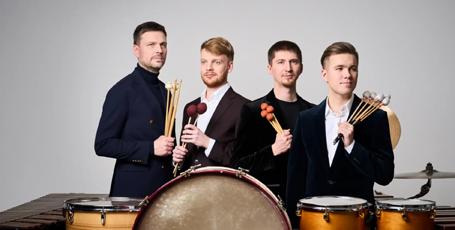
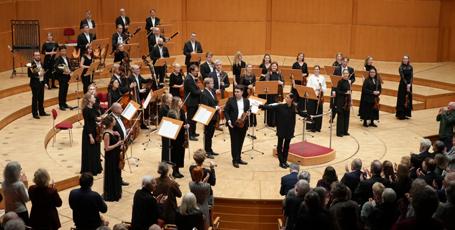
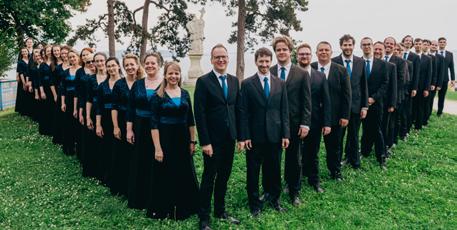
NEW LISZT FERENC CHAMBER CHOIR
A Liszt Ünnep Nemzetközi Kulturális Fesztivál ingyenes kiadványa
Kiadja: Müpa Budapest Nonprofit Kft. Felelős kiadó: Káel Csaba vezérigazgató Nyomdai kivitelezés: Pátria Nyomda Zrt.
A címlapon: Arvo Pärt Címlapfotó: Eric Marinitsch
Szerkesztő: Molnár Szabolcs
A szervezők a szereplő- és műsorváltoztatás jogát fenntartják.
E-mail: info@lisztunnep.hu
Telefon: +36 1 555 3000
lisztunnep.hu
